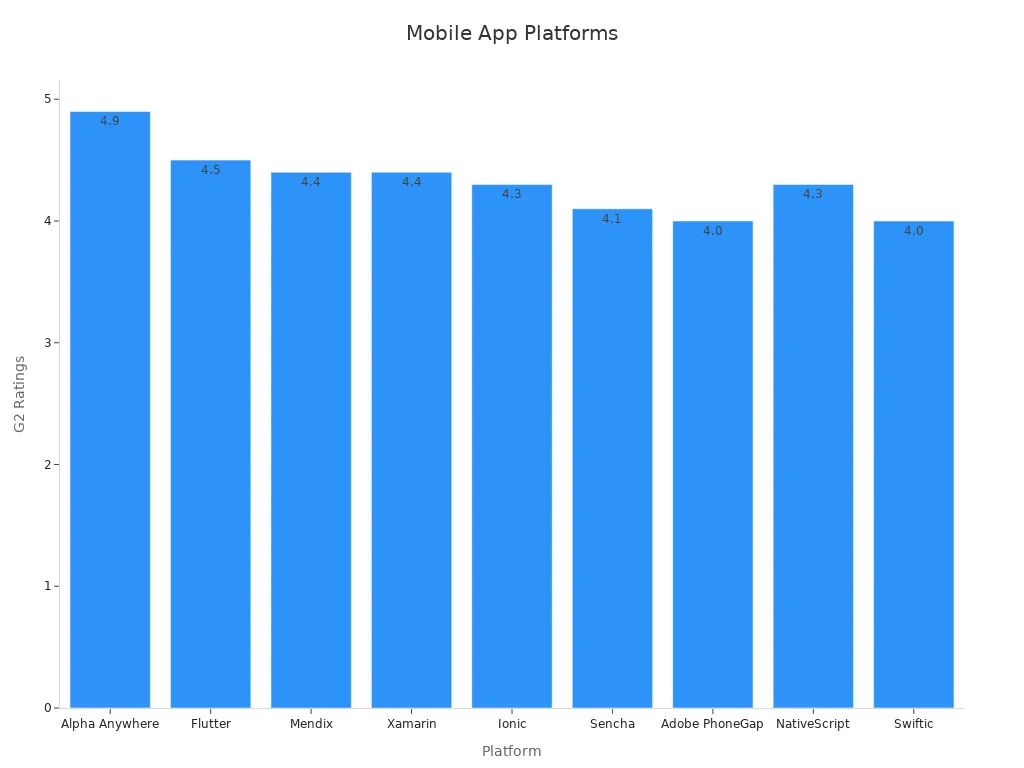Best Platforms for Business App Development and Scalability

Choosing the right platform for business app development is crucial. Leading tools such as Momen, Microsoft Power Apps, OutSystems, Mendix, and Google AppSheet enable you to create effective applications tailored to your requirements. Scalability, reliability, and efficiency are essential factors when selecting software, ensuring that your business can grow seamlessly without any issues.
Criteria for Choosing the Best App Development Software
Scalability and Performance
Scalability and performance are very important for app software. The platform should handle more users without slowing down. Checking things like response time, CPU use, and errors can help. These show if the platform works well for your needs.
KPI | Description |
|---|---|
Response times | Shows how fast the app answers user requests. |
CPU & memory usage | High usage means the app may need more resources. |
Network traffic | More traffic can slow apps; scaling may be needed. |
Error rates | More errors mean the app struggles with too many users. |
Throughput | Tracks how many tasks the app handles at once. |
Platforms like Momen are great for scaling. They support up to one million users daily while staying fast.
Ease of Use and Learning Curve
Easy-to-use platforms save time when learning new tools. Simple interfaces and guides make it easier to start. For example, React Native is good for JavaScript users. Flutter might take longer to learn. Tools like Momen are simple for both new and skilled developers. This lets you focus on building apps, not learning the tool.
Integration Capabilities with Existing Systems
Integration helps your app work with other systems easily. Features like data sharing, task automation, and third-party connections improve efficiency. For example:
Data sharing keeps information updated for better decisions.
Task automation saves time by reducing manual work.
Third-party connections link your app to other tools.
Platforms like Momen make it easy to fit apps into current workflows.
Cost and Licensing Models
App platforms have different pricing plans. Some, like Mendix, can be expensive for small teams. Others, like Momen, offer clear pricing with no surprises. Knowing the costs helps you plan your budget and avoid extra fees.
Customization and Flexibility
Customization lets you design apps for your specific needs. Flexible platforms grow with your business, staying useful over time. For example, Momen offers many ways to customize apps. This ensures your app fits your business perfectly.
Top Platforms for Business App Development

Momen
Momen is a no-code tool for building apps easily. You can create custom apps without writing any code. It works well for beginners and experienced developers. Momen combines frontend, backend, and database tools in one place. This makes it great for businesses wanting to simplify app creation.
Momen is also highly scalable. It can handle up to one million users daily. This ensures your app works smoothly as your business grows. Launching apps is simple with one-click deployment and automated processes. Its clear pricing avoids hidden fees, making it affordable for all businesses.
Tip: Momen connects with third-party APIs and workflows. This helps you build apps that fit your exact needs.
Microsoft Power Apps
Microsoft Power Apps is a low-code platform for mobile apps. It works well with Microsoft tools like Teams and SharePoint. This connection improves productivity and makes tasks easier. Its low-code design helps you build apps quickly to meet business demands.
Strengths | Description |
|---|---|
Microsoft tool integration | Works smoothly with Microsoft tools for better workflows. |
Low-code design speeds up app creation. | |
Scalability | Built on strong cloud systems for all business sizes. |
Customization options | Easy for simple apps, with advanced features for complex ones. |
Security and compliance | Follows strict rules like GDPR and HIPAA for safety. |
Power Apps is great for secure, enterprise-level apps. Its scalability and security make it a trusted choice for businesses.
OutSystems
OutSystems is a strong tool for building enterprise apps. It uses visual tools to make frontend and backend development easier. Its scalability and ability to connect with other systems suit large projects.
Pros of OutSystems:
Speeds up development with visual tools.
Connects well with existing systems.
Includes features like data encryption for safety.
Cons of OutSystems:
Costs more for small businesses.
Harder to learn for beginners.
OutSystems is perfect for businesses needing powerful, scalable apps. Its tools for managing app lifecycles and reusable parts save time and effort.
Google AppSheet
Google AppSheet is a no-code platform for mobile apps. It works well with Google Cloud, ensuring smooth performance. AppSheet handles large amounts of data, making it great for growing businesses.
Note: AppSheet works on many devices and scales well for certain apps. But apps that can't be split into parts may slow down with more data.
AppSheet's simple design and mobile-first focus make it ideal for quick, cross-platform app development.
Zoho Creator
Zoho Creator is a flexible tool for building custom apps. It has an easy-to-use interface and is budget-friendly. Many industries, like healthcare, use it for fast app creation.
Zoho Creator helped build a Health and Safety app in just one hour during COVID-19.
Its simple design allows quick updates and smooth communication.
Zoho Creator's low cost and ease of use make it popular with small and medium businesses.
Salesforce App Cloud
Salesforce App Cloud is a strong platform for enterprise apps. It uses a modular design and scalable data system to grow with your business. Its cloud tools adjust resources automatically for better performance.
Key Features:
Adjusts resources automatically for changing workloads.
Services in different locations reduce delays.
Tools for real-time monitoring improve app performance.
Salesforce App Cloud's scalability and ability to connect with other systems make it a top choice for enterprise apps.
Scalability Considerations for Business App Development

How Platforms Handle Increased User Demand
Scalability is very important for app software. It helps apps work well when more people use them. Platforms use different methods to keep apps running smoothly. They track things like user requests, active users, and errors. For example, Momen can handle up to one million users daily. This makes it reliable even during busy times.
Platforms use tests to find weak spots. They also add resources to improve performance. Cloud platforms often use auto-scaling. This means they adjust resources automatically when needed. These methods help apps stay fast and easy to use, even with many users.
Examples of Businesses Scaling with These Platforms
Real-life examples show how platforms help businesses grow. Brush Claims made a product that handles more users safely. HEINEKEN used a system in over 80 countries. This shows how platforms support global growth while keeping quality high. These examples prove app platforms meet big business needs.
Cloud-Based vs. On-Premises Scalability
Choosing between cloud or on-site systems depends on your needs. Cloud platforms are flexible. They let you add or remove resources easily. They cost less upfront, and providers manage the resources for you. On-site systems give more control but need expensive hardware and maintenance.
Aspect | Cloud-Based Scalability | On-Premises Scalability |
|---|---|---|
Flexibility | Easy to add or remove resources | Needs careful planning and setup |
Cost | Cheaper upfront, no big investments needed | High costs for hardware and software |
Resource Management | Managed by providers, saving your team’s time | Your team must handle all maintenance |
Cloud platforms are great for quick growth and cross-platform apps. On-site systems are better for businesses needing full control.
Comparison of the Best Mobile App Development Platforms
Key Features of Each Platform
When picking app software, knowing key features is important. Here's a simple comparison:
Platform | Programming Language | Price | Cross-Platform Deployment | Ratings (G2) |
|---|---|---|---|---|
Alpha Anywhere | HTML, CSS, JavaScript | $99/month | iOS | ⭐ 4.9 |
Flutter | C, C++ | Free | iOS, Android, Web | ⭐ 4.5 |
Mendix | HTML5, Java | Free | All platforms | ⭐ 4.4 |
Xamarin | C# | $25/month | Android, iOS, Windows | ⭐ 4.4 |
Ionic | HTML, CSS, JavaScript | Free | Mobile, Web, Desktop | ⭐ 4.3 |
Sencha | HTML, CSS, JavaScript | Free | Android, iOS, Kindle | ⭐ 4.1 |
Adobe PhoneGap | HTML, CSS, JavaScript | Free | iPhone, Android, Tizen | ⭐ 4.0 |
NativeScript | JavaScript, TypeScript | $19/month | iOS, Android | ⭐ 4.3 |
Swiftic | JavaScript | $57/month | iOS | ⭐ 4.0 |

Pros and Cons Summary
Each platform has good and bad points. Here's a quick look:
React Native: Builds apps fast with hot reloading and a big community. But it struggles with animations and hardware access.
Flutter: Runs smoothly with AOT compilation and great animations. However, apps are bigger, and the community is smaller.
Xamarin: Offers native-like performance and good hardware access. Yet, it’s harder to learn and updates slowly.
Choosing between native and cross-platform depends on your goals. Native apps work better but need more effort. Cross-platform apps save money and time but may lack specific optimizations.
Ideal Use Cases for Each Platform
The best app software depends on your business needs. Here are some examples:
Momen: Great for startups needing easy, no-code solutions that grow.
Microsoft Power Apps: Perfect for big companies needing strong system connections.
Flutter: Best for apps with rich visuals and smooth animations.
Xamarin: Good for businesses needing apps with native-like performance.
Zoho Creator: Ideal for small businesses wanting affordable, custom apps.
Low-code and cross-platform tools are becoming more popular. They help build apps faster and improve user experience, making them essential today.
Picking the right platform helps your business succeed. Tools like Momen are easy to use and grow with your needs. Microsoft Power Apps and Salesforce App Cloud are strong for big companies. Think about your goals, team skills, and if the platform can handle mobile growth.
Tip: Reviews from real users, like Gong’s success story, show how important it is to pick platforms that give good results and happy users.
FAQ
What is the best platform for no-code app development?
Momen is a great pick for no-code app creation. It has an easy-to-use design, smooth connections, and supports up to one million users daily.
Tip: Try Momen's free plan to test its features safely.
How do I choose the right app development platform for my business?
Look for scalability, simplicity, integration options, and clear costs. Platforms like Momen offer fair pricing and strong tools for different business needs.
Can I scale my app as my business grows?
Yes, many platforms, like Momen, provide scalable options. They manage more users and keep apps running well without extra hardware.
Note: Cloud platforms often adjust resources automatically for easier scaling.
See Also
Top 30 Innovative Web App Concepts for 2025 Startups
Comparing Bubble And Softr For Business App Development
Top No-Code Tools For Freelancers To Use In 2025
